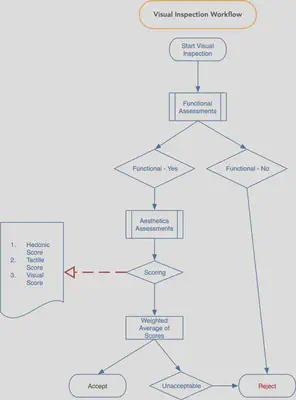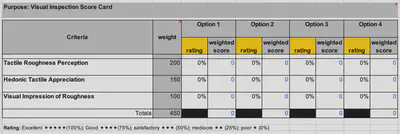Subjective Quality in 3D Printing
 Image credit: Unsplash
Image credit: UnsplashIn my work, I usually conduct 2 types of quality inspections. These are objective and subjective. The objective inspection reviews the measurements of an object. The subjective inspection is based on my opinion of the print’s quality. For my research I have developed a scoring methodology for a subjective visual inspection.
The visual inspection will consist of the following steps outlined in Figure 1.

This study will utilize the visuotactile perception classification based on the work of Ramananantoandro et al. (2014), An assessor classifies an object based upon a scale of 1-5 (1 being the worst value and 5 the best) expressed as percentages. The three characteristics to be classified are as follows:
- Hedonic tactile appreciation - this characteristic is the preference of the object based upon touch (Ramananantoandro, Larricq, & Eterradossi, 2014).
- Tactile roughness perception - this characteristic is the determination of roughness based upon touch (Ramananantoandro et al., 2014).
- Visual impression of roughness - this characteristic is the determination of surface roughness based upon sight only (Ramananantoandro et al., 2014).
The weighted averages of the aesthetics assessment will be determined as follows:
- Tactile Roughness Perception (200) - The face shield headband is meant to be worn on the head. Potentially, medical personnel could be wearing the face shield for long streets of time and comfort is key. The “feel” of the headband is the most important aesthetic factor.
- Hedonic Tactile Appreciation (150) - Although not as important as the feel of the band, the look of the band can help increase perceptions.
- Visual Impression of Roughness (100) - the visual inspection of roughness is given the least weight. This decision was made due to the possibility of varying colors of bands. In Ramananantoandro et al. (2014), it was noted that the color of wood samples had an impact on the impression of roughness. In an emergency, the production of items such as PPE should not be restricted to colors.
Figure 2 represents a template for the visual inspection. The scores will be utilized to help identify optimized print parameters.
Figure 2: Visual Inspection (Aesthetics) Score Card

The equations used to determine the weighted inspection score is as follows:
WS = W * R
Where:
- WS is Weighted Score
- W is Weight
- R is the rating expressed as a percentage
By applying this methodology, I should be able to successfully score any of my prints. As long as I adhere to the process, the subjective quality can be scored and be correct relative to the other prints I score.
Ramananantoandro, T., Larricq, P., & Eterradossi, O. (2014). Relationships between 3D roughness parameters and visuotactile perception of surfaces of maritime pinewood and MDF. Holzforschung, 68(1), 93-101.
Link used are Amazon affiliate program links